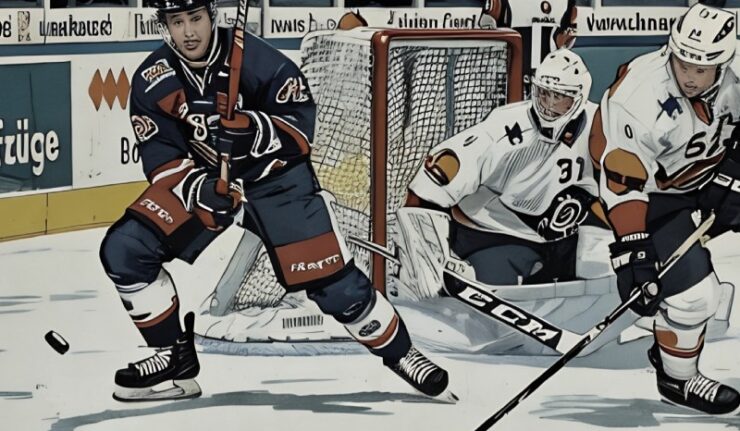For decades, the world of professional sports maintained a firewall between the game and the gamble. The specter of fixed contests and compromised integrity was a haunting fear, capable of eroding public trust and turning athletic competition into a scripted drama. The National Hockey League, like its counterparts, built its reputation on the unscripted thrill of the contest. Yet, throughout its history, the league has been forced to confront the persistent shadow of gambling, from rudimentary betting rings in the Original Six era to the complex legal and ethical quandaries of the modern, sports-betting-saturated world. While hockey has been spared a scandal on the scale of baseball’s 1919 Black Sox, its history is punctuated by significant incidents that have tested the league’s resolve, shaped its policies, and served as cautionary tales for generations of players.
The Original Sin: The 1940s and the Forging of a Zero-Tolerance Stance
The post-war era was a different world. Gambling, though officially illegal in most jurisdictions, was a woven part of the urban fabric, and sports were a prime target. The NHL first had to formally address the issue in 1946. Babe Pratt, a charismatic, popular, and talented defenseman for the Toronto Maple Leafs, was found to have been betting on NHL games. While he maintained he only ever bet on his own team to win, the league, under President Red Dutton, acted swiftly, suspending him for what was intended to be a lifetime ban. However, Pratt’s immense popularity and the argument that he hadn’t bet against his team led to a successful appeal. He was reinstated after just nine games, but the incident served as a stark warning. The NHL Board of Governors issued a clear edict: any player caught gambling on any hockey game in the future would be banned for life.
This new, hardline policy would be tested just two years later in a scandal that would become the benchmark for gambling transgressions in the NHL for over half a century. The case involved two players: Billy Taylor of the New York Rangers and Don Gallinger of the Boston Bruins. Gallinger, a promising young star, and Taylor, a veteran, had become involved with a Detroit-based gambler named James Tamer. An investigation, spearheaded by a determined new NHL President, Clarence Campbell, uncovered undeniable proof that both players had bet on games, including, most damningly, wagering against their own teams.
The details were grim. Taylor had approached Gallinger, explaining how they could supplement their modest salaries by providing inside information and placing strategic bets. For three months, they wagered amounts ranging from $250 to $1,000 on multiple games. The betrayal of their teammates and the sport itself was absolute.
President Campbell, a former Rhodes Scholar and prosecutor at the Nuremberg trials, saw the issue in black-and-white terms. The integrity of the game was paramount. On March 9, 1948, he handed down the harshest possible sentence: Taylor and Gallinger were banned from the NHL for life. There was no ambiguity, no room for appeal. Campbell’s decision was a powerful statement that reverberated across the league. It established a zero-tolerance precedent that would define the NHL’s public stance on gambling for the next 70 years. The message was unequivocal: the sanctity of the on-ice competition was absolute, and any player who threatened it would be cast out permanently. It wasn’t until 1970, more than two decades later and long after their playing days were over, that the league reinstated the two men.
Operation Slapshot: A Modern Brush with the Underworld
Following the Taylor-Gallinger affair, the league entered a long period of relative quiet on the gambling front. The issue would not return to the headlines in a major way until the new millennium. In February 2006, the hockey world was stunned by news of “Operation Slapshot,” a major investigation by New Jersey State Police that dismantled a multi-million-dollar sports betting ring. The scandal’s tendrils reached directly into the NHL.
The central figure with hockey ties was Rick Tocchet, a celebrated former player and then-assistant coach for the Phoenix Coyotes, coached by his friend and hockey icon, Wayne Gretzky. The investigation alleged that Tocchet was a partner in the ring, financing and facilitating its operations. The scandal intensified when it was revealed that one of the high-profile bettors using the service was Janet Jones, an actress and the wife of Wayne Gretzky. The media frenzy was immediate and intense, with the specter of hockey’s greatest player being even tangentially connected to an illegal gambling operation.
However, as the investigation unfolded, a crucial distinction emerged. While the ring took bets on professional and collegiate football and basketball, authorities and the NHL’s own internal review found no evidence that Tocchet, Jones, or any other involved parties had ever wagered on NHL games. This was a critical point. The crime was not compromising the integrity of hockey, but rather participating in an illegal bookmaking enterprise with alleged ties to organized crime.
In the end, Jones was never charged, as simply placing a bet with a bookie was not a crime in New Jersey. Tocchet pleaded guilty in 2007 to conspiracy and promoting gambling. He avoided jail time, receiving two years of probation. He was suspended indefinitely by the NHL but was reinstated in 2008 after a thorough league review. “Operation Slapshot” was a serious affair that highlighted the proximity of illegal gambling to the sport, but because it never touched the on-ice product, the league was able to frame it as a law-and-order issue rather than a crisis of integrity.
The New Era: Addiction, Allegations, and Legalization
The landscape of sports gambling changed forever in 2018 when the U.S. Supreme Court struck down the federal ban on sports betting. This decision opened the floodgates, and in a remarkable turn, the NHL, once a staunch opponent of gambling, embraced it. The league and its teams began signing lucrative partnership deals with sportsbooks, and betting odds became a feature of broadcasts. This new reality created a complex and challenging environment, giving rise to new kinds of gambling-related issues.
The case of Evander Kane illustrated one of these new challenges. In 2021, Kane, then a star forward for the San Jose Sharks, faced shocking allegations from his estranged wife, who claimed on social media that he had bet on and was “throwing” his own games. This was the ultimate accusation, a direct echo of the 1948 scandal. The NHL launched an immediate investigation. After a thorough review, the league announced it had found no evidence to substantiate the claims.
The story, however, did not end there. Kane, through public statements and bankruptcy filings, admitted to having a severe gambling addiction, having lost millions of dollars. This cast the issue in a new light. While the league cleared him of compromising games, it revealed a different kind of danger in the new era: player welfare. In an environment where gambling is not only legal but actively promoted by the league itself, the risk of players developing devastating addictions is a significant concern.
The league’s first major disciplinary test in the age of legalized betting came in October 2023 with Ottawa Senators forward Shane Pinto. The NHL suspended Pinto for 41 games—half a season—for “activities relating to sports wagering.” In its announcement, the league was quick to state that its investigation found no evidence that Pinto had wagered on NHL games. This was a crucial distinction, meant to reassure the public that the on-ice product remained pure.
For months, the exact nature of Pinto’s violation remained a mystery. He later revealed that his transgression was “proxy betting.” While in Canada, he had a friend in the United States place bets for him through an American online account. This act, while seemingly minor to a casual observer, was a clear violation of league policy and, in some contexts, the law. The Pinto suspension was a definitive statement from the NHL. It drew a new, clear line in the sand for the modern era. The message was that while the league profits from sports betting, its players are to have no part in it, directly or indirectly. The severity of the suspension was a signal that any violation of the league’s meticulously crafted gambling policies would be met with significant consequences.
From the lifetime bans of Taylor and Gallinger to the half-season suspension of Pinto, the NHL’s journey with gambling has been one of constant adaptation. The league has moved from a simple, black-and-white world where any association with betting was a cardinal sin, to a far more complex reality where it must simultaneously profit from, promote, and police the very activity it once condemned. The history of hockey’s gambling scandals is a story of how a sport has fought to protect its integrity against a persistent and ever-evolving threat, a battle that is far from over.



